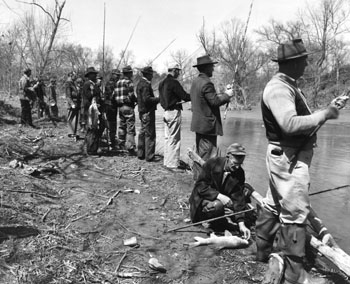Cold War Period (1945-1989)

>Home
>History Introduction
>Bibliography
>Historic Sites and Events
>Photo Gallery
>Next
World War II’s end ushered in the nuclear era and the fear of a Communist takeover of the entire world. Heightened alert called for new facilities to help ensure national security. One result was the transformation of the bulk of Camp Forrest land into the Arnold Air Force Base and the creation of the Arnold Engineering research and development facility. General Hap Arnold pressured President Harry Truman to make the Army Air Corps a stand-alone branch of the military, creating the Air Force. Creation of the Air Force and Arnold Air Force Base, Arnold Engineering, and the University of Tennessee Space Institute put the Duck River watershed in the center of U.S. Cold War strategy.
The end of World War II played a key role in the genesis of the Civil Rights movement. Black soldiers overseas found respect and freedom of mobility abroad that they failed to enjoy at home. In 1947, a black U.S. Army veteran and his mother from Columbia suffered abuse at the hands of a white merchant who considered his actions “uppity.” The veteran stood up for himself, leading to retaliation by racist elements of Maury County. This led to a riot that gained national attention. Some scholars argue that the Mink Slide Riot and the reaction to it made an impact on President Harry Truman, who integrated the U.S. Army in 1948. Integration of the army emboldened a number of members of the black community to pursue their Civil Rights. The movement gained momentum in 1954 with the Supreme Court Case Brown V. the Board of Education of Topeka, Kansas, in which the justices said that public schools must be integrated with “all deliberate speed.” Governor Buford Ellington initially resisted the Civil Rights movement but was persuaded to re-examine his stance on race. He later effectively used his office as governor to improve race relations in Tennessee.
The 1960s witnessed financial and industrial expansion across the region. President Lyndon B. Johnson, promoting his Great Society, funneled large amounts of federal funds into the area in a number of wide-ranging projects from water treatment plans to public parks. Passage of the Higher Education Act made college more accessible to the average individual and ensured the futures of Motlow State Community College and Columbia State Community College.
For residents of the region, the 1970s were more problematic. Escalating costs of the war in Vietnam crippled the economy. The concomitant Arab Oil Embargo and stagflation slowed the economic growth of the 1960s. As a result, a second round of outmigration hit the area as some businesses went under or had to lay off employees.
Life improved during the 1980s as the economy slowly corrected itself. Governor Lamar Alexander made a number of aggressive moves to improve the situation and the visibility of the state of Tennessee. One of his most important ventures was seeking outside investment into the state. He successfully negotiated with a number of Japanese companies to invest in the Volunteer State and establish factories here, most notably Nissan. (Others included YKK Zippers, Toshiba, Kubota, and Bridgestone.) The success of the Nissan plant at Smyrna (and the opening of the Tombigbee Waterway) caught the attention of General Motors, prompting them to purchase land at Spring Hill and create a new division of the company, Saturn. By the end of the Cold War, many people in the Duck River watershed and across Tennessee were involved in the automotive industry and its subsidiary components.
Alexander also invested capital into developing the tourist industry in Tennessee. The Duck River watershed enjoyed robust growth in the tourist market, making it an important destination for visitors and Tennessee residents. The Walking Horse festival in Shelbyville continued to grow throughout the period, and Columbia’s Mule Day continued to be a perennial draw. The region is still home to a number of state parks, natural areas, and historic sites.